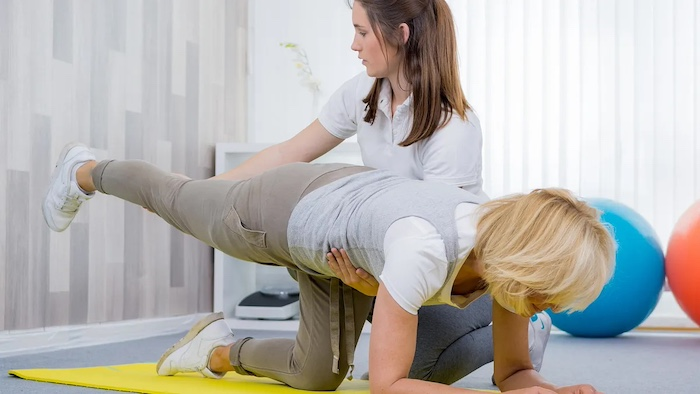
Rehabilitation and exercise are an essential part of recovery from a lumbar spine fusion. Careful planning and follow-through on a prescribed physical therapy program will go a long way in helping the patient recover from the fusion and have the best prospects for pain relief over the long term.
Patients who have had or are contemplating lumbar fusion surgery are understandably concerned about making sure the fusion heals as intended. For this reason, many patients are afraid to be active and some do not want to move at all, fearing that they will risk having the fusion not set up properly.
In actuality, and contrary to this fear, movement is essential to foster healing.
There are precautions to remember most patients avoid bending, lifting, and twisting but staying active with short, frequent, gentle exercise is strongly recommended and delivers many benefits.
Benefits of Physical Therapy After Fusion
Careful, progressive return to activity and exercise after a fusion has several advantages, including:
Movement Activates Supporting Muscles
Following surgery or an episode of injury, smaller muscles in the area may become inhibited (turned off). These muscles have a great responsibility in maintaining the stability of the spine. Encouraging the muscles to function properly will also reduce stress through the surgical site by active stabilization.
Gentle Stretching Promotes Flexibility
During periods of inactivity, range of motion can be lost, and stiffness soon settles in. Very gentle stretching of the core back and abdominal muscles, as well as the hip muscles attached to the spine and pelvis, will make all movement easier, even just getting out of a chair. Care must be taken to avoid being too aggressive too early, or a setback could undercut the intended benefit.
Activity encourages healing blood flow
Movement and activity promote healthy blood circulation, and blood brings the oxygen required to the healing site. Lack of oxygen will delay or sometimes prevent the healing of tissues and healthy bone growth, which are critical to a successful fusion outcome.
In addition to the physical benefits, a careful return to normal activity has many emotional and psychological benefits, such as the production of endorphins the body's natural pain-killing chemicals —and the feeling of well-being from staying active, enjoying fresh air and sunshine, and more.
Avoiding activity after fusion surgery will do more harm than good for patients. Although doctors will have different opinions about the kind and intensity of postoperative activity and exercise recommended, most types of fusion will show better outcomes if a prescribed physical therapy and exercise program is followed.
Checking with the surgeon performing the fusion both before and after surgery will help patients get the right advice for their specific situation.
Besides the above activities, patients who have a history of smoking mustn't use nicotine postoperatively. Nicotine kills the osteoblasts that grow bone (bone-growing cells) and the postoperative results of patients who go back to smoking are much worse than those who remain off of nicotine.
Although remaining nicotine-free for the first three months after surgery is the most critical, smoking even after a solid fusion is achieved has been well correlated to chronic low back pain.
Precision Pain Care and Rehabilitation has two convenient locations in Richmond Hill – Queens, and New Hyde Park – Long Island. Call the Queens office at (718) 215-1888 or (516) 419-4480 for the Long Island office to arrange an appointment with our Interventional Pain Management Specialist, Dr. Jeffrey Chacko.













